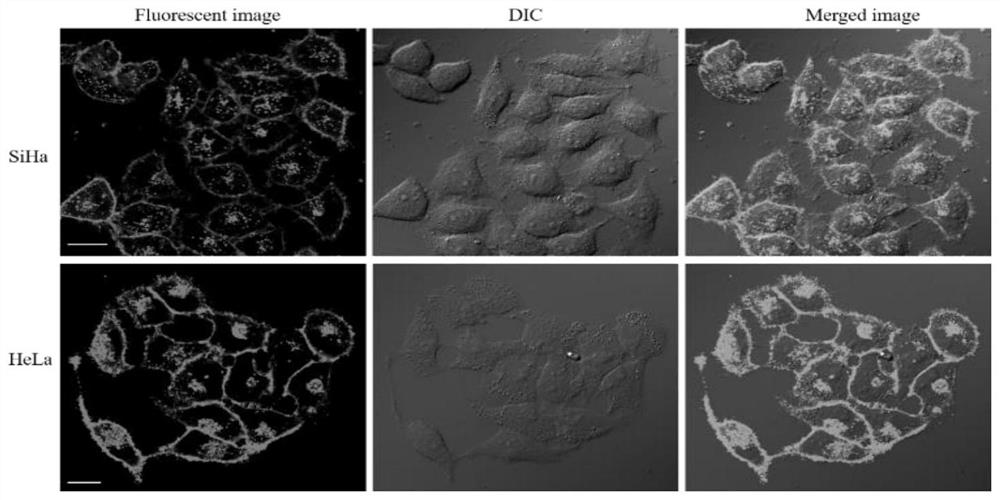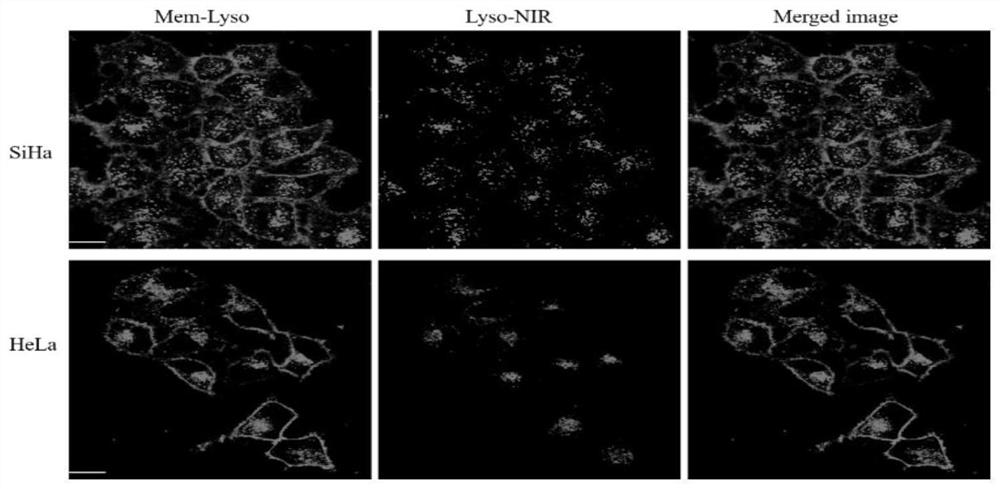Double-targeting fluorescent probe capable of simultaneously visualizing plasma membrane and lysosome and application of double-targeting fluorescent probe
A fluorescent probe and dual-targeting technology, applied in the field of probes for displaying plasma membranes and lysosomes, can solve problems such as inability to meet imaging requirements, and achieve universal, low-cost, and easy-to-scale production Effect
- Summary
- Abstract
- Description
- Claims
- Application Information
AI Technical Summary
Problems solved by technology
Method used
Image
Examples
Embodiment 1
[0041] MEM-LYSO synthesis and characterization
[0042] Compound 2 is 4-methyl-1-octadecylpyrid-1-iodide (0.357 g, 0.754 mmol) and anhydrous methanol (25 mL), add three flasks, 55 ° C is heated to all dissolved, and then Compound 4, 6- (dimethylamino) -2-nolds (0.177 g, 0.754 mmol) and piperidine (6 droplets). After the addition is completed, the temperature is increased and refluxed to reddish brown solid precipitation, resulting in (E) -4- (2- (6- (dimethylamino) naphthalene-2-yl) vinyl) -1-octadecylpyridine - 1-ammonium iodide, MEM-LYSO, 0.22 g, and a yield of 45%.
[0043] 1 H NMR (DMSO-D 6 ., 300MHz): δ (PPM): 8.80 (D, J = 8 Hz, 2H), 8.11 (D, J = 8 Hz, 2H), 8.02 (D, J = 16 Hz, 1H), 7.91 (S, 1H), 7.67 (m, 3H), 7.39 (D, J = 16Hz, 1H), 7.17 (m, 1H), 6.88 (S, 1H), 4.37 (D, J = 16 Hz, 2H), 2.98 (S, 6H), 1.16 (m, 32H), 0.76 (D, J = 12 Hz, 3H) .hrms (m / z): Calcd for c 37 Hide 55 In 2 : 654.34; Found: 527.44 (m-i) + .
Embodiment 2
[0045] MEM-LYSO Optical Performance Test
[0046] First, select the chromatographic pure solution of polarity as a solvent, and seven 6 solvents such as 1,4-dioxane, THF and DMF were selected. 5 μl of probe molecules were added thereto, and a probe molecular solution was formulated into a final concentration of 10 μm. It is then collected, and its absorption and fluorescence spectroscopy are collected, and the maximum emission peak is analyzed to obtain data of its absorption and emission spectrum, and the state of the Stokes displacement, the molar absorbance coefficient, the fluorescence quantum efficiency and other light physical parameters are calculated.
[0047] See figure 1 .
[0048] figure 1 : MEM-LYSO absorption spectroscopy (A), fluorescence spectrum (B) and normalized fluorescence spectroscopy (C) in different solvents. Concentration: 10 μm.
Embodiment 3
[0050] Stained living cell
[0051] According to the initial design, the probe MEM-LYSO can target the plasma film and lysosomes in the cell. To verify this feature, first use MEM-Lyso to dye the living cells to see if it can simultaneously imaging the plasma membrane and lysosomes. figure 2 Indicated. from figure 2 In the contour of the cells, the contour of the cells have green fluorescently drawn, which demonstrates that MEM-Lyso can be accurately imaging film.
[0052] See figure 2 .
[0053] figure 2 : Fluorescent images of SiHA and HeLa cells stained with MEM-LYSO, DIC and their superimposed images (2 μm, 10 min). λ ex = 488 nm, λ em = 500-600 nm, BAR = 20 μm.
PUM
 Login to View More
Login to View More Abstract
Description
Claims
Application Information
 Login to View More
Login to View More - R&D
- Intellectual Property
- Life Sciences
- Materials
- Tech Scout
- Unparalleled Data Quality
- Higher Quality Content
- 60% Fewer Hallucinations
Browse by: Latest US Patents, China's latest patents, Technical Efficacy Thesaurus, Application Domain, Technology Topic, Popular Technical Reports.
© 2025 PatSnap. All rights reserved.Legal|Privacy policy|Modern Slavery Act Transparency Statement|Sitemap|About US| Contact US: help@patsnap.com



